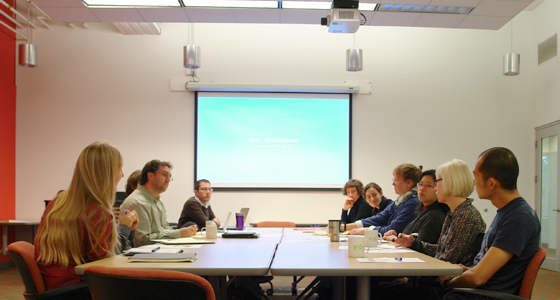“Sometimes, locating who else on campus shares a common interest is the hardest thing. A CoP facilitates the process of discovering these unknown but desirable connections.”
– David Kohler, member of the TA Training Community of Practice

Photo by Mike Baird, flickr.bairdphotos.com
What is a Community of Practice?
 Etienne Wenger, a leading proponent of communities of practice, defines them as groups whose members “share a passion for something they do and who interact regularly to learn how to do it better” (Wenger 2006). At CTLT, there are three key elements that differentiate community of practice sessions from other workshops or events:
Etienne Wenger, a leading proponent of communities of practice, defines them as groups whose members “share a passion for something they do and who interact regularly to learn how to do it better” (Wenger 2006). At CTLT, there are three key elements that differentiate community of practice sessions from other workshops or events:
1. Every participant has something to give and something to learn. Communities of practice focus on aspects of day-to-day teaching and learning practice, allowing participants with any level of experience to both learn from others and share experiences. For example, the Problem-Based Learning community involves members who have been integrating or would like to integrate problem- and case-based learning, the Peer Review of Teaching community involves those in an instructional role who engage in peer review, and the Teaching and Learning for the Heart and Mind community engages participants who have been integrating or would like to integrate contemplative practice into their work.
2. The topic, structure, and frequency of community meetings are determined by participants. Some groups prefer to host member spotlights or host guest speakers, others tend to lead guided discussion on topics of interest; some communities meet every month, while others meet once every six months. Facilitators of communities of practice do not repeat the same topics each year – rather, they listen to the direction provided by community members. If you are looking to further explore a topic related to one of the communities, mention it to the facilitator(s). Not sure what you’d like to explore? Keep watching www.events.ubc.ca for topics of upcoming events in all communities.
3. ‘Peripheral participation’ is expected, and encouraged. Community ‘membership’ is as simple as joining an email list or attending a community meeting. All meetings and emails are open to any member of the UBC teaching and learning community. Some communities, such as Course Design, Portfolio, and Instructional Design host blogsites where you can engage with community content online. Other communities share their ideas primarily in-person, with gatherings of between 5 and 25 participants focusing on a specific area of practice at each meeting.
Why Join a Community of Practice?
 Community of practice members find that one of the most useful aspects of communities of practice is networking with individuals from across campus.
Community of practice members find that one of the most useful aspects of communities of practice is networking with individuals from across campus.
Ara Beittoei, a staff member at the Community Learning Initiative who has attended meetings of the Sustainability Across the Curriculum Community of Practice shares her thoughts on communities of practice.
“I am introduced to a different perspective, outside of my normal interaction with colleagues. We have a shared interest, but are doing different things – it’s a great networking opportunity.”
Catherine Rawn, a faculty member in the Department of Psychology and member of the TA Training Community of Practice, explains why meetings are well worth the time spent.
“We routinely work together to exchange ideas based on what’s working well in our programs, and we help each other brainstorm solutions to challenges…Members come and go from year to year, but that common goal and supportive spirit continues. This is one of the major potential strengths of a CoP – it’s not adding to workload, yet at the same time it provides a safe place for ongoing professional development. Plus, we get to meet great people from across campus, which is something relatively rare at a place as huge as UBC.”
Joanna Pedersen, the Acting Assistant Director of Education in the eHealth Strategy Office and member of the Instructional Design Community of Practice, concurs.
“I attend community of practice meetings because I want to know what other people across campus are doing, develop a network with professionals in the space, and generally stay informed on innovative activities across campus and beyond.”
Joanna considers herself a core member of the Instructional Design Community of Practice, and has also ‘dropped in’ as a peripheral member in several other communities of practice, where the topics are of interest to her.
David Kohler, a PhD student in Mathematics and member of the TA Training Community of Practice, speaks to the chance to both benefit and contribute to a community.
“The flexibility of the format that a CoP usually takes makes it really easy to participate and contribute. We often attend workshops and events to receive something. By participating in a CoP, I actually get a chance to receive as much as I can give to others. This is at the source of what it takes to create a community.”
These members are just some of thousands of faculty, graduate students, staff, and others who benefit from communities of practice by receiving emails, attending meetings, or participating regularly.
CTLT currently partners with units across campus to host 13 communities of practice focusing on a wide range of topics. Whether you’d like to ‘drop in’ or become a regular member, the best way to get started is to join a community list online or sign-up for a community of practice meeting that interests you. You’ll find ideas and people you can connect with – and we’ll always provide coffee and cookies.
This article was published in the November 2012 CTLT Newsletter, Dialogues. Below is a list of the articles included in the issue:
- Faculty Spotlight: Daniel Heath Justice and Lisa Nathan
- Peer Review of Teaching: What’s in it for Me?
- Communities of Practice at UBC (currently viewing)
- New Teaching and Learning Resources
- Other Professional Development Events at UBC
Find out more information about the CTLT Newsletter, Dialogues.


[…] Learn more about communities of practice and the benefits of joining. […]
[…] By the way, if you’re interested in learning a bit more about communities of practice, there is a good brief summary in the latest issue of UBC’s Teaching and Learning Centre blog. […]